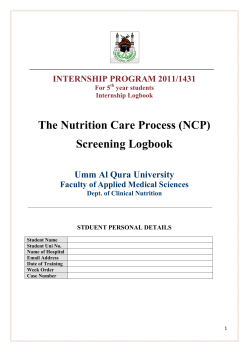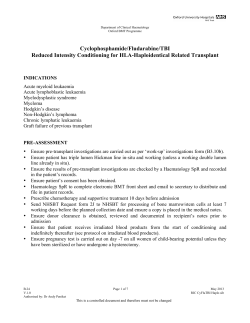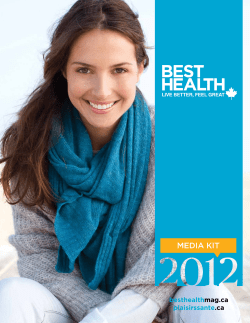
重症病患營養評估與營養支持 Outline 台北馬偕醫院 許碧惠 營養師
重症病患營養評估與營養支持 台北馬偕醫院 許碧惠 營養師 2009.09.24 AM 10:40-12:20 1 Outline ¾ Metabolic responses to critical illness ¾ Clinical consequences of malnutrition ¾ Nutrition assessment ¾ Nutrition support Enteral feeding Parenteral nutrition ¾ Monitor Refeeding Overfeeding ¾ Case study 2 1 Metabolic responses to critical illness ¾Hypermetabolism ¾Hypercatabolism ¾Lean body mass wasting ¾Hyperglycemia ¾Fluid accumulation 3 The metabolic alterations of the stress response Metabolic parameters Rate compared to normal Resting energy expenditure Increased Oxygen consumption Increased Carbohydrate metabolism blood sugar concentration gluconeogenesis glycogenolysis tissue glucose uptake/oxidation Increased Increased Increased Increased Fat metabolism ketogenesis lipolysis tissue uptake/oxidation Protein metabolism net synthesis net breakdown hepatic synthesis muscle synthesis ureagenesis No change / Decreased Increased Increased Decreased Increased Increased Decreased Increased 2 Physiologic changes associated with stress response response physiologic benefit Potential physiologic risk Protein catabolism Ensure adequate substrate for acute phase response, gluconeogenesis, wound healing, immune function ¾Functional tissue loss ¾Hypoalbuminemia Hyperglycemia Ensure substrate availability ¾Hyperglycemia ¾Immune dysfunction ¾Osmotic diuresis ¾Hyperosmolarity ¾Protein glycosylation Sodium and water retention Maintain intravascular volume ¾Hyponatremia ¾Hypervolemia ¾Pulmonary edema ¾Congestive heart failure ¾Hypokalemia ¾Hypomagnesemia Increase heart rate and cardiac output Maintain organ perfusion ¾Increase cardiac work ¾Increase myocardial ischemia ¾Arrhythmias Hypercoagulability; increased platelet aggregation Hemostasis ¾Microvascular thrombosis ¾Deep venous thrombosis ¾Pulmonary embolus Increase sympathetic tone Increase cardiac output Increase substrate availability (glycogenolysis, lipolysis) ¾Increase myocardial irritability ¾Hyperglycemia ¾Inhibits insulin ¾Shunting of blood flow to central organ, away from gut Clinical consequences of malnutrition ¾ Immune dysfunction ↑ infection risk ¾ Lean body mass ↓ ¾ Impaired skeletal and respiratory muscle strength Î ventilator dependence ¾ Poor wound healing ¾ ↑ organ dysfunction ¾ ↑ morbidity and mortality ¾ ↑ hospital stays 6 3 Cause and types of malnutrition Marasmus Kwashiorkor Combined Nutritional setting ↓ Calories and protein intake ↓Protein intake ↓calories & protein, stress Clinical setting starvation, anorexia, elderly, Chronic illness Fad diets, NPO or clear liquids >5 days catabolic stress without nutriton Time to develop Months-years weeks-months days-weeks Clinical features Starved appearance: Wt. < 80% IBW Wt. Loss > 10% may look well nourished or obese: Wt. > 90% IBW Wt. Loss > 10% Mod.–severely starved appearance Wt. < 80% IBW Lab findings Alb. > 3.0 Alb< 3.0 Alb. < 3.0 Clinical course preserved responsiveness to short term stress ↓wound healing ↑ infections ↑ complications ↓wound healing , recovery high high Mortality rate low 7 Purposes of nutrition assessment ¾Identifies who are malnourished and/or at nutritional risk ¾Permits evaluation of the efficacy of nutritional support 8 4 Nutrition assessment ¾Subject parameters Medical history Nutrition history ¾Objective parameters Physical examination Anthropometric measurements Various body composition methodologies Laboratory tests Clinically specific parameters 9 Nutrition screening criteria Diagnosis and past medical history associated with increased nutritional risk Diagnosis and current clinical condition Past surgical history Preexisting medical condition Diet information History of poor nutrient intake Recent changes in intake Restrictive dietary habits Tolerance of diet Physical assessment Obvious muscle wasting, excessive body fat Cachexia Edema, ascites Abdominal assessment Anthropometric data Height Current weight Weight change Laboratory data (if available) Visceral proteins (albumin, prealbumin, transferrin) Liver function tests Lymphocyte count Hemoglobin 5 History(medical & nutrition) ¾Direct interview (patient or family) Change in oral intake GI symptoms Weight loss Functional ability ¾Social history Income, size of family,… 11 Altered dietary intake ¾duration of altered intake ¾gut function Anorexia, vomiting, diarrhea, abd. Pain, decreased or unusual food intake, and chronic illness. ¾limited mobility ¾function and difficulties with smell and taste 12 6 Physical examination Physical examination Nasal esophageal, mucosal ulceration Palatability– taste fatigue Stoma- functional Urine— output, color Gastric output– amount, color Temperature Nausea/vomiting Abdominal distension Appetite– anorexia, hungry, dry mouth, mouth sores Nutrient intake versus prescribed or estimated required intake Intravenous site intact (uninfected or inflamed) Bowel function– stool frequency, consistency, color Medications– potential drug-nutrient interactions, GI side effects Anthropometric data ¾Height Knee height: 9M: Ht(cm)=64.19-(0.04×age)+(2.02×KH) 9F: Ht(cm)=84.88-(0.24×age)+(1.83×KH) 14 7 Anthropometric data ¾ BW measurement ( Index of PEM) Pre-injury BW ¾ IBW: IBW=(Ht ÷ 100)2×22 15 Anthropometric data ¾BMI BMI < 18.5 kg/m2 Î chronic energy deficiency BMI ≥ 30 kg/m2 Î ↑ morbidity in critically ill 16 8 Anthropometric data— Body weight change %IBW=actual weight ÷ ideal body weight×100 ≧200% ≧130% 110 -120% 80 - 90% 70 - 79% < 69% Morbidly obese Obese Overweight Mild malnutrition Moderate malnutrition Severe malnutrition 17 Anthropometric data— Body weight change % of UBW=Current weight ÷ usual weight × 100 85%~95% 75%~84% < 74% mild malnutrition moderate malnutrition severe malnutrition 18 9 Anthropometric data— Body weight change % BW change = (usual wt- actual wt) ÷ (usual wt)× 100 time 1 week 2-3 wks 1 month 3 month 6 month Significant change (%) 1-2 2-3 5 7 10 Severe change (%) >2 >3 >5 >7 >10 19 Anthropometric data ¾Mid arm circumference (MAC) ¾Mid arm muscle circumference (MANC) ¾Skinfold thickness (poor indicator) 20 10 Laboratory tests– hepatic transport proteins Serum protein Function Clinical significance and other comments Albumin 3.5-5.0 g/dL < 2.1 severe depletion 2.1-2.8 moderate depletion 2.8-3.5 mild depletion Normal value 21 days Half life Maintain plasma oncotic pressure, carrier for amino acids, zinc, magnesium, calcium, FFA, drugs ¾Routinely available ¾Useful in long term nutritional assessment ¾Limited value in short term nutrition indicator ¾Reliable prognostic indicator of morbidity and mortality ¾Synthesized in liver Transferrin 200-400 mg/dL < 100 severe depletion 100-150 moderate depletion 150-200 mild depletion 8 -10days Binds iron in plasma and transports to bone Prealbumin 10-40 mg/dL <5 severe depletion 5-10 moderate depletion 10-15 mild depletion 2-3 days Binds thyroxin, carrier or RBP Retinal binding protein (RBP) 2.7-7.6 mg/dL 12 hours ¾Strongly influenced by iron status ¾Synthesized in liver ¾Increased levels with pregnancy, estrogen and iron therapy, acute hepatitis, iron deficiency, chronic blood loss and dehydration ¾Decreased levels with hepatic disease, protein losing states, hemolytic anemia, metabolic stress ¾Useful as short term nutritional index ¾Better index of visceral protein especially in acute states of PCM ¾Synthesized in liver ¾Increased levels with renal dysfunction ¾Decreased levels with acute catabolic states, post surgery, hyperthyroidism, liver disease, PCM ¾Reflects acute changes in protein malnutrition and changes in dietary intake ¾Limited use in renal failure ¾Increased levels in CRF and pt use oral contraceptives ¾Decreased levels with Vit A def, PCM, acute catabolic states, post surgery, hyperthyroidism, liver disease Transports vitamin A in plasma, bind to prealbumin Laboratory tests– Total lymphocyte count ¾WBC: turnover is rapid ¾Need: energy and protein ¾TLC < 1500/mm3: poor outcome ¾TLC= WBC × % lymphocytes ¾Hypoalbuminemia, metabolic stress, infection, cancer,chronic diaease 22 11 Effect of single and combined observations on morbidity and mortality observation Albumin < 3.5 TLC < 1500 Albumin+TLC complications Death 4× 2× 4× 6× 4× 20 × 23 Others ¾Creatinine height index (CHI) CHI=(actual 24-h creatinine excretion) ÷ (expected 90%~80%: mild depletion creatinine excretion ) 60%~80%: moderate Expected creatinine excretion: < 60% : severe ♀:IBW× 18 mg/kg ♂:IBW× 23 mg/kg ¾Nitrogen balance NB=(protein intake ÷ 6.25)-(UUN + 4) NB: 0 maintenance NB:+2~+4 for repletion 24 12 Muscle function test ¾Hand grip strength ¾Resp. muscle strength ♥ Correlate with wt. loss and PEM ♥ Reflect shorter-term energy balance Handgrip dynamometer. 25 Criteria used to identify malnutrition in hospitalized patients Weight Weight for height % ideal body weight BMI Weight loss Body composition Anthropometrics skin fold Limb circumference Biochemical hepatic secretory protin albumin prealbumin transferrin C-reactive protein Hematologic hemoglobin lymphocyte count Urinary urea nitrogen excretion Energy intake Energy expenditure Functional indices Grip strength pulmonary function tests pulmonary muscle strength non-volitional muscle function 13 Energy requirement Goal: maintain not repletion ¾ Mild ~ moderate stressed : HBEE×1.2 ~ 1.3 ¾ Severely stressed : HBEE × 1.4 ~1.5 H-B equations: ♂: HBEE=66+13.8(W)+5 (H)-6.8(A) ♀: HBEE=655+9.6(W)+1.8 (H)-4.7(A) Obese p’t: use adjusted body weight ABW=(CBW-IBW)×0.25+IBW 25~30 kcal/kg/day 27 Energy requirement ¾Ireton-Jones equations(IJEE) Spontaneously breathing patients: EEE=629-11(Age)+25(Weight)-609(Obesity; 0=absent, 1=present) Ventilator-dependent patients: EEE=1784-11(Age)+5(Weight)+244(Gender; 0=female, 1=male)+239(Trauma; 0=absent, 1=present)+804(Burn; 0=absent, 1=present) 28 14 Protein requirement Proteolysis > synthesis ¾Obese, critically ill patient: 1.5 ~ 2.0 g/ kg ABW or IBW ¾None obese, critically ill patient: 1.2~2.0 g/kg BW ¾15-20% of TLC UUN → protein requirement UUN≒10 g/day Æ 1.2 ~1.3 g/kg BW UUN≒25 g/day Æ 2.0 g/kg BW 29 Protein requirement(A.S.P.E.N ;2009) ¾ BMI<30 kg/m2 Æ 1.2~2.0 g/kg actual BW or NPC:N=70:1~100:1 ¾ BMI>30 kg/m2 Æ < 60-70% of target energy requirement 11-14 kcal/kg actual body weight 22-25 kcal/kg IBW Protein: ≥ 2.0 kg/kg IBW ¾ BMI>40 kg/m2 Æ ≥ 2.5 kg/kg IBW 30 15 How much fat does the ill patient need ? ↑ Lipolysis Î serum FFA ↑Î hepatic reesterification ↑ (hepatic TG formation ↑ ) ¾ 10~30% of TLC ¾ ENÆ depend on absorb and digest the lipid ¾ ≒15 ~25 g/day Æ absorption fat-soluble vitamins ¾ PN Æ 3~5% of total calories give as EFA ¾ Infusion rate: < 0.1g/kg/h ¾ Monitor: serum TG, liver function 31 How much CHO does the ill patient need ? •Primary fuel of the CNS,RBC,.. •hyperglycemia ¾The amount of CHO to administer to critical care patients is related to the amount that can be oxidized by the liver. ¾Min. dose: 100 g/day ¾50~60% of TLC ¾PNÆ4 ~6 mg/kg BW/min Endogenous glucose production is not suppressed by exogenous glucose administration. 32 16 Fluid and electrolytes Maintain adequate urine output and electrolytes level ¾Fluid: 35 mL/kg Keep I/O balance ¾K, P, Mg ¾Monitor: I/O , BW, electrolytes 33 A metabolic model of critical illness description Nutrition/metabolic intervention Acute critical illness ¾Permissive starvation ¾Prioritize protein/amino acids, (nonprotein fuels may not be necessary) Prolonged acute critical illness ¾Ensure adequate protein/amino acids ¾Permissive nonprotein underfeeding Chronic critical illness ¾Ensure adequate protein/amino acids ¾Ensure adequate and consistent nutrition without overfeeding Recovery ¾Conventional nutrition targets (25-35 kcal/kg/d) Nutr Clin Pract, Vol. 21, No. 6, 587-604 (2006) 34 17 Nutritional support route Initiate EN 時需注意 ¾P’t weight loss ¾Previous nutrient intake ¾Level of disease severity ¾Comorbid conditions ¾GI tract function 36 18 Enteral feeding ¾Early feeding ( within 48 hrs) ¾Benefits: ↓ the effects of hypercatabolism and hypermetabolism More physiologic, cheaper, and safer than TPN Protective effects on gut mucosa and liver Lower rates of infections than TPN 37 ESPEN Guidelines on Enteral Nutrition: Intensive care (Clinical nutrition 2006 25:210-223. ) ¾ Indications: All patients who are not expected to be on a full oral diet within 3 days should receive enteral nutrition (EN). ¾ Exogenous energy supply: during the acute and initial phase of critical illness: in excess of 20–25 kcal/kg BW/day may be associated with a less favorable outcome. during the anabolic recovery phase, the aim should be to provide 25–30 kcal/kg BW/day. Patients with a severe undernutrition should receive EN up 25–30 total kcal/kg BW/day. 38 19 Guidelines for Nutrition Support Therapy in the Adult Critically Ill Patient (JPEN 2009 33: 277-316) (A.S.P.E.N) ¾ Energy requirements may be calculated by predictive equations or measured by indirect calorimetry. simplistic formulas (25-30 kcal/kg/d) ¾ Efforts to provide >50%-65% of goal calories should be made in order to achieve the clinical benefit of EN over the first week of hospitalization ¾ If unable to meet energy requirements (100% of target goal calories) after 7-10 days by the enteral route alone, consider initiating supplemental PN. 39 Nutrition goals in the chronic critical illness syndrome Substrate Goals Total calories Protein ¾18-25 kcal/kg/d ¾1.2-1.5 g/kg/d Monitor serum levels of urea nitrogen and ammonia May require additional protein if ongoing loss (ie, decubiti, fistulas) ¾50%-60% total energy requirements (60%-70% of nonprotein calories) Advance carbohydrate to goal when euglycemia (blood glucose level of 80 to 110 mg/dL) is achieved ¾20%-30% total energy requirements (30%-40% of nonprotein calories) Carbohydrate Lipid Nutr Clin Pract, Vol. 21, No. 6, 587-604 (2006) 40 20 Intolerance of EN: ¾ Abd. distention ¾ Formula reflex ¾ Gj ↑ , >250 mL ¾ Nausea, vomiting ¾ Diarrhea ¾ Abd. pain Algorithm for checking gastric residual volumes. Reprinted from reference 41 with permission from the American Association of Critical-Care Nurses. Nutr Clin Pract, Vol. 24, No. 3, 335-343 (2009) Implementation--TPN high output small bowel fistula s/p ileal or colon resection no bowel sounds uncontrollable diarrhea “If the gut works, use it.” 42 21 Nutrient Sources in Parenteral ¾ Protein( amino acid) Requirements: 9 For healthy adult: 0.8 g/kg 9 In critical illness: 1.2~2.5 g/kg 9 Hepatic encephalopathy or renal failure: protein restriction Optimal protein intake: 9 Nitrogen balance ( (protein intake÷6.25)-UUN+4) 9 15~20% of total daily calories. 9 Normal individuals, 300 nonprotein calories are needed for optimal utilization of 1 g of nitrogen. 9 In critical illness: 100~150 NPCÆ 1 g nitrogen 43 Nutrient Sources in Parenteral Protein( amino acid) sources : Aminosteril Aminosteril N-Hepa Nephrosteril Aminol-RF Aminoplasmal Moriamin-SN 濃度 5% 8% 7% 7.4% 10% 10% 克數 (ml/瓶) 25 g (500 ml) 40 g (500 ml) 17.5 g (250 ml) 14.8 g (200 ml) 50 g (500 ml) 20 g (200 ml) BCAA↑ EAA ↑ 不含NEAA (除Histidine外) TPN used TPN used 特性 44 22 Nutrient Sources in Parenteral ¾Carbohydrate (Dextrose): Requirements: 9Minimal needs: 1 mg/kg/min eg, 70 kgÆ 100.8 g/day 9Maximal needs: ≈ 5 mg/kg/min eg, 70kgÆ 504 g/day 45 Nutrient Sources in Parenteral Dextrose sources : ED5% (D5W;D5S) D10W (NakoNo.5) 0.45%GS NakoNo.1 NakoNo.4 濃度 5% 10% 2.5% 3.8% 0.8% Kcal/bot 85 170 42.5 64.6 13.6 克數 (ml/瓶) 25 g (500 ml) 50 g (500 ml) 12.5 g (500 ml) 19 g (500 ml) 4g (500 ml) 46 23 Nutrient Sources in Parenteral ¾Fat: (provide EFA) Requirements: 910% of calories from soy or safflower oil emulisions Æ prevent EFA deficiency Optimal fat intake: 9≈ 20~30% of calories 47 Nutrient Sources in Parenteral Fat sources : Intrafat Lipofundin MCT/LCT Lipovenoes MCT/LCT % 10% 10% 20% Soybean oil (g) 20 1.1 200 220 5 1.022 100 102.2 25 1.908 250 477 Kcal/ml Ml/bot Kcal/bot 48 24 Monitoring ¾CRP ↓ ¾Alb ↑ ¾Wound healing ↑ ¾Refeeding ¾Overfeeding 49 Effects of refeeding syndrome Hypophosphatemia Altered cardiac function Altered hematologic effects hepatic dysfunction Neuromuscular effects Respiratory effects Hypokalemia Cardiac effects Gastrointestinal effects Metabolic effects Neuromuscular effects Hypomagnesemia Cardiac effects Gastrointestinal effects Neuromuscular effects Glucose and fluid introlerance 25 Impact of overfeeding Hyperglycemia Phagocyte dysfunction Osmotic diuresis Increased risk of infection Intracellular shifts of electrolytes Excessive CO2 production Respiratory failure Prolonged mechanical ventilation requirements Organ system dysfunction Hepatic dysfunction (steatosis) Cardiac dysfunction (refeeding syndrome) Respiratory dysfunction (refeeding syndrome) Neurologic dysfunction (refeeding syndrome) Recommendations for initiating and monitoring nutrition support Nutrient Guidelines Calories Initiate with < 20 kcal/kg or 1000 npc; maintain for ~2- 5day; increase as tolerated per patient Protein 1.2~1.5 gm/kg/day; increase as tolerated monitoring BUN and creatinine, liver function tests Carbohydrates 150~200 gm/day; increase based upon glycemic control and insulin requirement Lipid ≤ 1 gm/kg/day; infuse over 18-24 hours; monitor serum triglyceride levels for tolerance Fluid usually maximal concentration desired; monitor intake and output, weight change, peripheral edema, and tachycardia for fluid balance and signs for fluid overload Blood work monitor daily; P, Mg, BG, K, Na, Cl, HCO3-, BUN, Cr. Ca, Hb, pCO2 monitor bi-weekly: liver function tests, peralbumin, CRP, TG 26 Case study ¾ 70歲張老先生因食慾不振、fever、SOB多日至門診就 診,因肺炎收入院,因Hypoxic respiratory failure on MV 轉入ICU。家屬反應他三餐只吃半碗白稀飯加少許海苔 醬,整日臥床休息不想動。抽血生化值為Alb:2.7 g/dL, chol: 90 mg/dL, TG:35 mg/dL, BG:80 mg/dL, BUN:6 mg/dL, Cr.:0.4 mg/dL, K:3.0 mEq/dL, Na:131 mEq/dL, Cl:100 mEq/dL, GOT:40 IU/dL, GPT:22 IU/dL, CBC data: WBC:11.5 ×103/uL, Lym: 9.0%。張先生身高166公分, 目前體重50公斤,約3個月前體重58公斤且生活活動自 如。 ¾ 請問如何營養評估? ¾ 如何營養支持? ¾ 需monitor 那些data? 53 個案討論 ¾ 營養評估 營養攝取 < 250卡/天 體位資料: BH:166cm, IBW=60.6kg 9 BW:50kg (82.5% IBW) Î80 ~ 90% Mild malnutrition 9 BMI=18.1 kg/M2Î chronic energy deficiency 9 % UBW=86.2% Î 85%~95% mild malnutrition 9 % BW change=13.8% Î severe change Lab. Datas: 9 Alb:2.7 g/dLÎ 2.1-2.8 moderate depletion 9 Chol.: 90 mg/dL 熱量需求(Goal): 9 HBEE=1110 kcal×1.2~1.3=1332~1443 kcal 9 IJEE=1508 kcal 9 simplistic formulas:1250~1500 kcal 蛋白質需求: 1.2~2.0 g/kg Î 60~100g 54 27 個案討論 ¾營養支持 EN: NG feeding 可先給 < 20 kcal/kg ( < 1000 kcal/day) Æ goal 1500 kcal/day PN: ¾Monitor I/O, Gj, electrolytes, BS, PaCO2,… 55 56 28
© Copyright 2025





















